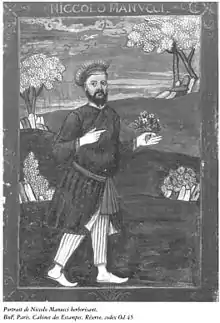Niccolao Manucci
Niccolao Manucci (19 April 1638–1717) was an Italian writer, doctor and traveller. He wrote a memoir about the Indian subcontinent during the Mughal era.[1] His records have been a source of history about Shah Jahan, Aurangzeb, Chatrapati Shivaji Maharaj, Dara Shikoh, Shah Alam, Raja Jai Singh and Kirat Singh. He never returned to Europe and settled down in India.
Niccolao Manucci | |
|---|---|
 Portrait of Niccolao Manucci. National Library of France, Cabinet of Prints, Paris. | |
| Born | 19 April 1638 Venice, now Metropolitan City of Venice, Italy |
| Died | 1717 (aged 79) Monte Grande, Chennai, now Tamil Nadu, India |
| Occupation | Physician, Historian, Geographer, Explorer |
| Notable works | Storia do Mogor (1698) |
| Years active | c. 1660 – 1717 |
Storia do Mogor
Manucci is famous for his work "Storia do Mogor", an account of Mughal history and life. Manucci had first-hand knowledge of the Mughal court, and the book is considered to be the most detailed account of the Mughal court. It is an important account of the time of the later reign of Shah Jahan and of the reign of Aurangzeb.
He wrote about his work: "I must add, that I have not relied on the knowledge of others; and I have spoken nothing which I have not seen or undergone..." .
Manucci spent almost his entire life in India. He would then send home the manuscript for "Storia do Mogor" which was lent to the French historian François Catrou in 1707. Catrou wrote another version as Histoire générale de l’empire du Mogul in 1715. The original then emerged in Berlin in 1915 and was written in three different languages. This version was translated and then published.
Works
Some of Manucci's works, reprints, and translations include:
- Manucci, Niccolao (1913). A Pepys of Mogul India 1653-1708. Translated by Irvine, William. New York: E.P. Dutton and Company.
- Manucci, Niccolao (1826). History of the Mogul dynasty in India, 1399 - 1657. Translated by François Catrou. London : J.M. Richardson.
- Manucci, Niccolao (1907). Storia do Mogor; or, Mogul India 1653-1708, Vol. 1. Translated by William Irvine. London, J. Murray.
- Manucci, Niccolao (1907). Storia do Mogor; or, Mogul India 1603-1708, Vol. 2. Translated by William Irvine. London, J. Murray.
- Manucci, Niccolao (1907). Storia do Mogor; or, Mogul India 1653-1708, Vol. 3. Translated by William Irvine. London, J. Murray.
- Manucci, Niccolao. Storia do Mogor; or, Mogul India 1653-1708, Vol. 4. Translated by William Irvine.
See also
References
- Niccolò Manucci (1965). Storia do Mogor: or, Mogul India, 1653-1708. by Niccolao Manucci. Translated with introd. and notes by William Irvine. Editions.
Further reading
- Eraly, Abraham. The Mughal World: Life in India's Last Golden Age. (London: Penguin Books. 2007).
- Manucci, Niccolao, Storia do Mogor, Eng. trs. by W. Irvine, 4 vols. John Murray, London 1906.
- Lal, K.S. (1988). The Mughal Harem. New Delhi: Aditya Prakashan. ISBN 978-81-85179-03-2.
- Lane-Pool, Stanley. Aurangzeb and the decay of the Mughal empire (Delhi: S. Chand & Co.1964)
- Ali, Sadiq. A vindication of Aurangzeb in two parts (Calcutta: New Age Press. 1918)
- Fasana-e-Saltanat-e-Mughlia. An Urdu Translation of Manucci diaries by Khan Bahadur Syed Muzaffar Ali Khan
External link
 Media related to Niccolò Manucci at Wikimedia Commons
Media related to Niccolò Manucci at Wikimedia Commons Quotations related to Niccolao Manucci at Wikiquote
Quotations related to Niccolao Manucci at Wikiquote